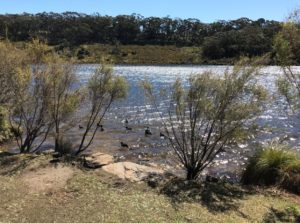
The number one priority of our trip to the Blue Mountains on 7th September was to hear Liz Benson’s talk about the Wollemi Pine at the Wentworth Falls History Centre. While we were there, as well as absorbing the views around the falls, we wanted to do some plant exploring on Kings Tableland, and also take a look at the location of Grevillea ‘Lawson Queen’, discovered by Pip Gibian in 1988.
After Liz Benson’s fascinating presentation, our first stop was Wentworth Falls Lake, which was created to supply water for the steam engines on the nearby railway. It’s a delightful park, very scenic and extensive, and features large sandstone sculptures of the seedpods of plants native to the area. Two endangered species, the Giant Dragonfly and the Blue Mountains Water Skink, live here. I shouldn’t really say this, but when I was a child I accidentally fell into the lake from the wharf – it was winter too.
I should mention the weather. It was extremely cold and windy. I checked the actual weather readings later for nearby Katoomba, and the day’s temperatures ranged between 2 and 4 degrees. The wind blew from the west-south-west at 46 kph with gusts much higher. At the lookouts near the top of the falls people were getting drenched as the water was blown up by the strong winds. On occasions not a drop of water seemed to be going down!
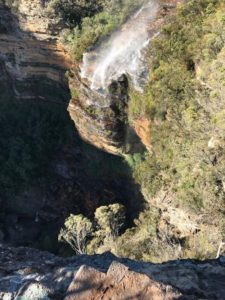
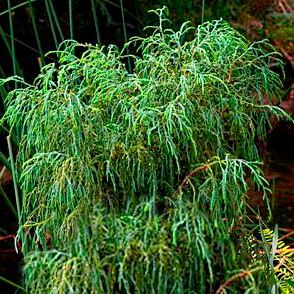
A small shrub that enjoys these constantly moist situations is Pherosphaera fitzgeraldii (formerly named Microstrobus fitzgeraldii) or Dwarf Mountain Pine. It’s an endangered species that only grows on wet rocks and ledges on south-facing waterfalls between Wentworth Falls and Katoomba, and we could see it in the distance.
The views of Jamison Valley and Mount Solitary were magnificent as usual. Now and again I get envious of people living in the mountains so close to such natural wonders. Except for the sometimes-extreme weather, of course.
In 1836 a young Charles Darwin visited the falls on his way to Bathurst. He wrote: “there is a view exceedingly well worth visiting . . . Below is the grand bay or gulf, for I know not what other name to give it, thickly covered with forest. The point of view is situated as it were at the head of the Bay, for the line of cliff diverges away on either side, showing headland, behind headland, as on a bold Sea coast . . .
This kind of view was to me quite novel and extremely magnificent.”
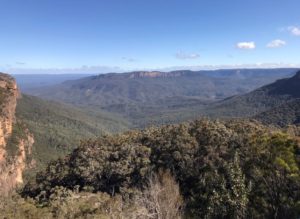
After a quick lunch we went across to Kings Tableland – along Tablelands Road, parked in Chester Road and took a wander down the bush track to Rocket Point Lookout. Here, right at the lookout and rather appropriately sprawled over the rocks opposite the falls was Darwinia fascicularis subsp.oligantha. This is an attractive decumbent shrub I’ve been growing in the garden for years. It’s very hardy, and where the branches contact the soil they usually take root.
The genus Darwinia was named after Charles Darwin’s grandfather, Erasmus Darwin, who was a well-known English physician. He was also a natural philosopher, physiologist, inventor and poet.
On this walk we noticed the flora was generally stunted, no doubt due to the harsh conditions and rocky terrain. The Proteacae family had by far the greatest representation here – Banksia cunninghamiana, B. ericifolia, B. oblongifolia, B. serrata, Hakea dactyloides, H. teretifolia, Isopogon anemonifolius, Petrophile pulchella and Lambertia formosa were spotted.
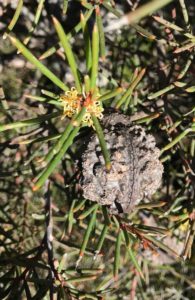
We bumped into (sometimes literally) a Hakea with yellow flowers and needle-like leaves that was vaguely familiar. I pondered over its identity for a few days, and came to the conclusion that it must be Hakea propinqua. Now, my reference books are fairly old, and after a bit more time I finally woke up. I noticed in my Fairley and Moore a note under Hakea propinqua that says: “A yellow flowered form in the higher Blue Mountains is now regarded as a new species, H. pachyphylla.” And do you know what? A few years ago, Alan Fairley had given me a plant of it (along with a few other unusual ones), and it’s still growing here! Hakea pachyphylla. Photo Lesley Waite.
Next, on to Lawson. Pip’s Grevillea ‘Lawson Queen’ is thought to be a natural hybrid between G. sericea and G. oleoides. It has large deep pink flowers and grows in a very small area north of Lawson. Pip has registered this plant with the Australian Cultivar Registration Authority, and her application notes said: “Thought to be a Grevillea sericea hybrid, possibly with G. oleoides which also occurs in the area. The differences are in the deepness of the pink in the flower colour and the leaf characteristics. The very best-coloured G. sericea comes nowhere near it. The leaves are much wider than G. sericea. The leaf is a much darker green than G. sericea. Grevillea sericea can be quite variable in leaf, and for a while it was thought it could possibly be a new species however it does not set seed suggesting it may be sterile hybrid.
It has been in the applicant’s garden since it was first collected.”
Today we found that the fire trail leading to the site of G. ‘Lawson Queen’ has a locked gate. It was late afternoon, and although quite close to its location we didn’t have quite enough time to continue our journey on foot. However, we did have a short meander in the bush just past the gate. There was plenty of Grevillea sericea and what I thought was G. oleoides here, the latter having large rose-pink flowers. However, when Pip saw Lesley’s photo below of one of these plants she thought it could be a hybrid. After all, there are many intergrades and look-alikes in the area, but there’s none as pretty as G. ‘Lawson Queen’.
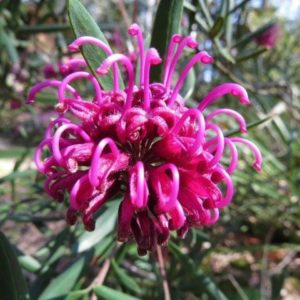 |
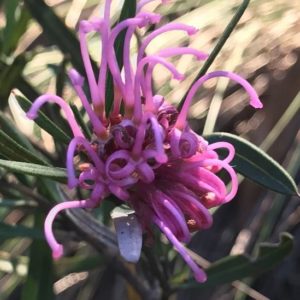 |
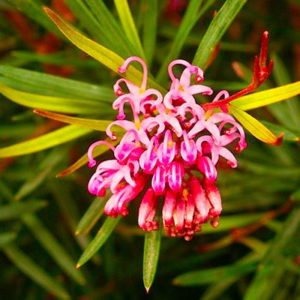 |
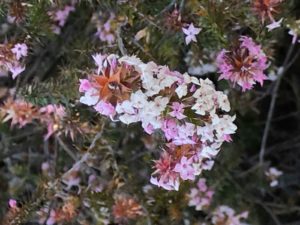
Here too was Woollsia pungens, on which most plants had a mixture of white and pink flowers. We had never seen this before – perhaps the pink flowers change colour to white as they age?
On a previous visit I had seen an unusual form of Grevillea laurifolia growing in this vicinity, with long upright leaves like rabbits’ ears.
It was getting dark. It had been a fabulous day, and we couldn’t have crammed anything more into it. Our passion of being totally immersed in native plants had been temporarily satisfied!
